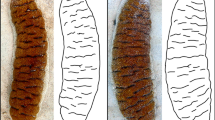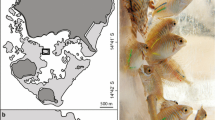Abstract
Range expansion by invasive taxa can be facilitated by a wide variety of life history traits, by behavioral repertoires, or via human-aided translocation. The round goby (Neogobius melanostomus) continues to expand its range in Europe and the Great Lakes watershed by moving upstream in tributary rivers and streams. It is not clear whether in-stream barriers (e.g., waterfalls, culverts, dams) will prevent further upstream expansion. Since other species within the Gobiidae are adept waterfall climbers, we investigated whether body scaling morphometrics, fused pelvic fin adhesion, or swimming patterns in round gobies were suggestive of climbing capability. Behaviorally, round gobies swam less frequently, limited their swimming mode to caudal thrusts, and sought shelter more as velocity increased. Attachment to the substrate via the fused pelvic fins was documented in a laboratory flume. Fish smaller than 5 cm or having a body mass less than 1.5 g had passive pelvic fin adhesion power sufficient to remain in place on a wetted, inclined plane, whereas larger fish did not. Small fish had significantly smaller pelvic fin area/length ratios relative to larger fish (P < 0.001), but significantly greater pelvic fin area/mass ratios (P < 0.001). Caudal fin area, but not fused pelvic fin area, exhibited an allometric growth pattern versus weight in large gobies, whereas neither caudal nor pelvic fin area showed allometric increases versus weight in small round gobies. Pelvic fin area in both large and small fish grew allometrically compared to length, whereas caudal fin area increased allometrically relative to length only in small fish. Fin morphometric results suggest, theoretically, that neither adults nor juveniles have pelvic fin areas large enough to support their weight against gravity forces, but the areas are sufficient to withstand hydraulic drag forces. Collectively, our results suggest that in-stream barriers which force fish to overcome gravity should be impassable, but that barriers allowing fish to remain submerged could be navigable.






Similar content being viewed by others
References
Blob RW, Rai R, Julius ML, Schoenfuss HL (2006) Functional diversity in extreme environments: effects of locomotor style and substrate texture on the waterfall-climbing performance of Hawaiian gobiid fishes. J Zool 268:315–324
Blob RW, Wright KM, Becker M, Maie T, Iverson TJ, Julius ML, Schoenfuss HL (2007) Ontogenetic change in novel functions: waterfall climbing in adult Hawaiian gobiid fishes. J Zool 273:200–209
Clemens BJ, Binder TR, Docker MF, Moser ML, Sower SA (2010) Similarities, differences, and unknowns in biology and management of three parasitic lampreys of North America. Fisheries 35:580–594
Copp GH, Bianco PG, Bogutskaya N, Erös T, Falka I, Ferreira MT, Fox MG, Freyhof J, Gozlan RE, Grabowska J, Kováč V, Moreno-Amich R, Naseka AM, Peňáz M, Povž M, Przybylski M, Robillard M, Russell IC, Stakénas S, Šumer S, Vila-Gispert A, Wiesner C (2005) To be, or not to be, a non-native freshwater fish? J Appl Ichthyol 21:242–348
Davenport J, Abdul-Matin AKM (1990) Terrestrial locomotion in the climbing perch, Anabas testudineus (Bloch) (Anabantidea, Pisces). J Fish Biol 37:175–184
Fulcher BA, Motta PJ (2006) Suction disk performance of echeneid fishes. Can J Zool 84:42–50
Gibson RN (1982) Recent studies on the biology of intertidal fishes. Oceanogr Mar Biol Ann Rev 20:363–414
Gutowsky LFG, Fox MG (2011) Occupation, body size, and sex ratio of round goby (Neogobius melanostomus) in established and newly invaded areas of an Ontario river. Hydrobiologia 671:27–37
Hayden TA, Miner JG (2009) Rapid dispersal and establishment of a benthic Ponto-Caspian goby in Lake Erie: diel vertical migration of early juvenile round goby. Biol Invasions 11:1767–1776
Hoover JJ, Adams SR, Killgore KJ (2003) Can hydraulic barriers stop the spread of the round goby? ANSRP Technical Notes, TN ANSRP-03-1, US Army Engineer Research and Development Center, Vicksburg, MS
Jude DJ, Reider RH, Smith GR (1992) Establishment of the Gobiidae in the Great Lakes Basin. Can J Fish Aquat Sci 49:416–421
Kemp PS, Tsuzaki T, Moser ML (2009) Linking behaviour and performance: intermittent locomotion in a climbing fish. J Zool 277:171–178
Kier WM, Smith AM (1990) The morphology and mechanics of octopus suckers. Biol Bull 178:126–136
Kornis MS, Vander Zanden MJ (2010) Forecasting the distribution of the invasive round goby (Neogobius melanostomus) in Wisconsin tributaries to Lake Michigan. Can J Fish Aquat Sci 67:553–562
Kornis MS, Sharma S, Vander Zanden MJ (2013) Invasion success and impact of an invasive fish, round goby, in Great Lakes tributaries. Divers Distrib 19:184–198
Krakowiak PJ, Pennuto CM (2008) Fish and macroinvertebrate communities in tributary streams of Eastern Lake Erie with and without round gobies (Neogobius melanostomus, Pallas 1814). J Great Lakes Res 34:675–689
L’avrinčiková M, Kovác V, Katina S (2005) Ontogenetic variability in external morphology of round goby Neogobius melanostomus from Middle Danube, Slovakia. J Appl Ichthyol 21:328–334
Ludwig HR Jr, Leitch JA (1996) Interbasin transfer of aquatic biota via angler’s bait buckets. Fisheries 21:14–18
Maie T, Schoenfuss HL, Blob RW (2007) Ontogenetic scaling of body proportions in waterfall-climbing gobiid fishes from Hawaii and Dominica: implications for locomotor function. Copeia 3:755–764
Maie T, Schoenfuss HL, Blob RW (2012) Performance and scaling of a novel locomotor structure: adhesive capacity of climbing gobiid fishes. J Exp Biol 215:3925–3936
McDowall B (2003) The key to climbing in the koaro. Water Atmos 11:16–17
Pennuto CM, Krakowiak PJ, Janik CE (2010) Seasonal abundance, diet, and energy consumption of round gobies (Neogobius melanostomus) in Lake Erie tributary streams. Ecol Freshw Fish 19:206–215
Poos M, Dextrase A, Schwalb A, Ackerman J (2010) Secondary invasion of the round goby into high diversity Great Lakes tributaries and species at risk hotspots: potential new concerns for endangered freshwater species. Biol Invasions 12:1269–1284
Reinhardt UG, Eidietis L, Friedl SE, Moser ML (2008) Pacific lamprey climbing behavior. Can J Zool 86:1264–1272
Sapota MR, Skora KE (2005) Spread of alien (non-indigenous) fish species Neogobius melanostomus in the Gulf of Gdansk (south Baltic). Biol Invasions 7:157–164
Sayer MDJ (2005) Adaptations of amphibious fish for surviving life out of water. Fish Fish 6:186–211
Schoenfuss HL, Blob RW (2003) Kinematics of waterfall climbing in Hawaiian freshwater fishes (Gobiidae): vertical propulsion at the aquatic-terrestrial interface. J Zool 261:191–205
Tierney KB, Kasurak AV, Zielinski BS, Higgs DM (2011) Swimming performance and invasion potential of the round goby. Environ Biol Fish 92:491–502
van Beek CW (2006) The round goby Neogobius melanostomus first recorded in the Netherlands. Aquat Invasions 1:42–43
Vogel S (1981) Life in moving fluids. Princeton University Press, Princeton
Walsh MG, Dittman DE, Gorman O (2007) Occurrence and food habits of the round goby in the profundal zone of southwestern Lake Ontario. J Great Lakes Res 33:83–92
Weimer MT (2003) The distribution of round goby (Neogobius melanostomus) in Eighteenmile Creek, Erie County, New York. Aquat Invader 14:2–4
Acknowledgments
This work was supported by a NY Sea Grant award to CMP (Research Foundation Award No. 50542). Special thanks are due to Caleb Basiliko and Mark Clapsadl of the Buffalo State Great Lakes Center for assistance in construction of the Vogel flume for swimming trials. Dr. Tom White and two anonymous reviewers provided feedback to improve the manuscript.
Author information
Authors and Affiliations
Corresponding author
Additional information
Handling Editor: Thomas Mehner.
Rights and permissions
About this article
Cite this article
Pennuto, C.M., Rupprecht, S.M. Upstream range expansion by invasive round gobies: Is functional morphology important?. Aquat Ecol 50, 45–57 (2016). https://doi.org/10.1007/s10452-015-9551-2
Received:
Accepted:
Published:
Issue Date:
DOI: https://doi.org/10.1007/s10452-015-9551-2




